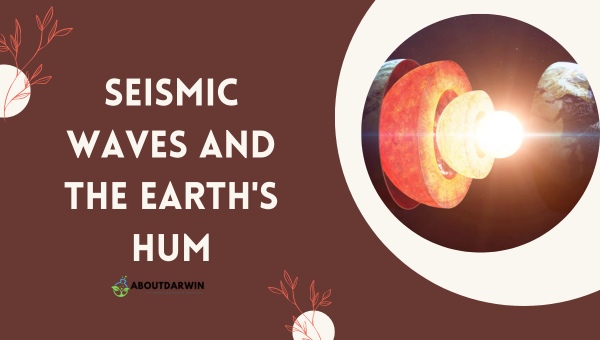Physical Address
304 North Cardinal St.
Dorchester Center, MA 02124
Have you ever wondered why our planet Earth hums? Well, it’s not just mere speculation but a scientifically proven phenomenon. You might be surprised to learn that the Earth constantly emits a low-frequency buzz or vibration, too faint for human ears to pick up. This humming may not grab headlines, but it has piqued the curiosity of scientists and researchers alike.
The Earth’s humming, also referred to as its “background-free oscillations,” has been a subject of extensive study since its discovery in the late 20th century. Determining what causes the Earth to hum is crucial, as it can provide essential insights into our planet’s internal structure and aid in predicting earthquakes more accurately.
So, what’s at the heart of this phenomenon? Various factors contribute to the Earth hum, ranging from natural occurrences such as ocean waves and atmospheric turbulence to human-driven activities such as urbanization and seismic instrumentation. Unraveling the mystery behind this natural “music” can help us better understand the workings of our world and allow us to navigate potential risks in the future.
Contents
The Earth’s hum is a fascinating phenomenon that has captured the attention of scientists and researchers for years. In simpler terms, it’s a continuous, low-frequency vibration that can be detected from the planet.

It’s not the result of human activities or environmental factors like earthquakes or winds, but rather, a natural and constant part of Earth’s behavior. Several theories attempt to explain this intriguing hum, and I’ll discuss a few of them below.
One widely accepted theory suggests that the Earth’s hum is caused by ocean waves crashing against the seafloor. As these waves interact with the planet’s solid surface, they generate vibrations that move through the Earth’s crust, causing a humming sound. This concept is supported by data that shows the hum is more likely to be detected in coastal areas.
Another theory proposes that the hum is a consequence of atmospheric pressure fluctuations. As the Earth’s atmosphere undergoes changes in pressure, it, in turn, influences the planet’s crust, creating vibrational resonances. The continuous and ever-shifting nature of atmospheric pressure contributes to the perpetual quality of the Earth’s hum.
Some researchers have also explored the possibility that tectonic activity plays a role in producing the hum. These activities, which include the slow movement of the Earth’s plates, create stress and vibrations felt throughout the planet. Microseismic activity and pressure changes within the Earth’s core could contribute to the buzzing sound.
It’s essential to note that these theories are not mutually exclusive – it’s possible that a combination of these factors, and potentially others, work together to create the Earth’s consistent hum.
Considerable research is dedicated to understanding and analyzing the Earth’s hum, as it may offer valuable insights into our planet’s inner workings. By studying this unique phenomenon, scientists can develop a better understanding of:
The Earth’s hum is a captivating, low-frequency vibration that plays an essential role in our exploration and understanding of Earth’s hidden secrets. While there are multiple theories to explain its existence, further research is necessary to uncover the exact mechanisms behind this mysterious hum.
I’ve researched thoroughly to understand the intriguing question: Why does the Earth hum? In this section, I’ll delve into several theories proposed by scientists and researchers to explain this mysterious phenomenon.

One prominent theory is ocean waves. As waves crash upon the shoreline and interact with one another, they generate pressure fluctuations that create a continuous, low-frequency vibration. This can cause the seafloor to reverberate, ultimately producing the hum.
Another possible source of the hum is atmospheric turbulence. According to this theory, the movements of the atmosphere cause small fluctuations in air pressure, which are then transmitted to the ground. As these pressure changes interact with the Earth’s crust, they may generate low-frequency sound waves.
Some researchers believe that the hum could also be the result of deep Earth movements. They argue that convective motions within the Earth’s mantle might be responsible for the vibrations. While this possibility is still being explored, it could potentially provide valuable insights into the Earth’s inner workings.
Here’s a summary of these theories:
| Theory | Main Idea |
|---|---|
| Ocean waves | Interaction of waves causing seafloor vibrations |
| Atmospheric turbulence | Pressure changes from atmospheric movements |
| Deep Earth movements | Convective motions within the Earth’s mantle |
Aside from these theories, it’s important to note that a combination of factors could cause the hum. We must also consider human-induced noise, such as traffic or industrial activity, which can also generate low-frequency sounds. However, the Earth’s hum has been detected in remote locations far from human activity, which suggests that the origin might lie within natural processes.
Several theories attempt to explain the mysterious sound of the Earth’s hum:
While the definitive cause of the Earth’s hum remains uncertain, these theories provide fascinating avenues of inquiry for researchers seeking to uncover the source of this enigmatic phenomenon.
Sea Level Rise: Factors, Consequences & Mitigation
You might wonder why the Earth hums. Seismic waves play a significant role in this phenomenon. In this section, I’ll explore how these waves contribute to the Earth’s hum and why they matter.

Seismic waves arise from various sources, including earthquakes, landslides, volcanic eruptions, and even human activities like mining or construction. These vibrations travel through the Earth’s crust, causing it to resonate like a massive bass drum. Consequently, the planet produces a constant, low-frequency sound, typically detected by sensitive equipment called seismometers.
Scientists have identified two main types of Earth’s hum:
It’s important to note that the Earth’s hum isn’t easily detectable by human ears. The frequency range generally oscillates between 2 and 7 millihertz. To put things in perspective, the human hearing range starts at around 20 hertz.
Studying the Earth’s hum offers several scientific advantages and insights:
Earth’s Hum Characteristics
| Characteristic | Value |
|---|---|
| Frequency Range | 2-7 millihertz |
| Human Hearing Range | ~20 hertz – 20 kilohertz |
Seismic waves play a crucial role in generating the Earth’s hum—a constant low-frequency sound that, although inaudible to humans, offers significant scientific potential. By studying these vibrations, researchers can expand their knowledge of global seismic activities and delve deeper into our planet’s inner workings.
One possible explanation for the Earth’s mysterious hum is ocean waves. As waves crash and move along the ocean floor, they generate vibrations. These vibrations travel through the Earth, resulting in a low-frequency sound that could contribute to the planet’s constant hum.
Researchers have examined the relationship between ocean waves and the Earth’s hum by analyzing seismic records during quiet periods. They discovered that the Earth’s hum is most prominent when there’s an increase in wave activity.
Some factors that influence wave-generated hum are:
A study conducted in 2015 focused on the effects of ocean waves on the Earth’s hum. It revealed that most of the planet’s low-frequency background noise could be attributed to microseisms, small seismic movements caused by ocean wave activity. The data from this study are summarized in the following table:
| Frequency Range (mHz) | Contribution to Earth’s Hum (%) |
|---|---|
| 2.9-4.9 | 68.6 |
| 4.9-13.7 | 27.4 |
| 13.7-20.0 | 4.0 |
While ocean waves provide a plausible explanation for the Earth’s hum, it’s essential to consider other factors, such as:
Ocean waves seem to play a significant role in creating the Earth’s hum. When coupled with the varying wave frequencies and topography, their pressure on the ocean floor floor floor leads to vibrations that travel through the Earth’s interior. However, it’s crucial to keep in mind that other factors, both natural and human-made, can influence this mysterious phenomenon as well.
One significant factor affecting the Earth’s hum is atmospheric influences. In this section, I’ll discuss how natural phenomena in the atmosphere contribute to the mysterious hum that our planet produces.
The first atmospheric influence on the hum comes from ocean waves. Ocean waves generate microseismic waves as they interact with the Earth’s surface. These microseismic waves propagate through the Earth’s crust, producing vibrations that contribute to the hum. In particular, there are two types of microseismic waves generated by different ocean wave interactions:
Another atmospheric factor that impacts the Earth’s hum is atmospheric turbulence. Turbulent air in the atmosphere can cause pressure changes on the Earth’s surface. This pressure variation leads to the generation of infrasound waves, which are low-frequency acoustic waves. When these infrasound waves reach the Earth’s crust, they induce vibrations contributing to the planet’s hum.
Seismic activity, such as earthquakes, can also play a role in the Earth’s hum. Although not a direct atmospheric influence, seismic events can produce vibrations that get trapped within the Earth’s surface waves, enhancing the overall hum.
It’s important to note that atmospheric conditions can also impact our ability to measure and detect the Earth’s hum. During periods of heavy precipitation or severe storms, the increased environmental noise can make it difficult for researchers to pick up on the hum using sensitive instruments.
To summarize, various atmospheric factors contribute to the Earth’s hum, including:
These factors add to the continuous, low-frequency vibrations we observe as the Earth hum. Understanding these influences helps us comprehend this curious phenomenon better and provides valuable insights into other aspects of our planet’s behavior.
When discussing the Earth’s hum, it’s crucial to understand the role of our planet’s core in producing this enigmatic phenomenon. The Earth’s core consists of two parts: the inner core and the outer core. These layers are composed of metals such as iron and nickel, with the inner core being solid and the outer core being liquid.
One of the dominant theories suggests that interactions between the outer core and the lower mantle generate the Earth’s hum. In this theory, the liquid outer core flows around the solid inner core, creating currents that create vibrations. These vibrations spread through the Earth’s mantle, producing the low-frequency hum we perceive.
Diving deeper into this theory, three main factors contribute to the outer core’s movements:
These contributing factors create complex patterns of flow within the outer core. As a result, the outer core and lower mantle interact in ways that produce vibrational energy. This energy then travels through the Earth’s layers, eventually reaching the surface where it can be detected as a low-frequency hum.
Although scientists are still trying to fully understand the role of Earth’s core in the humming sound, their studies have provided invaluable insights. For instance, examining the variations in the hum’s frequency can help researchers learn about the changing dynamics within the Earth’s interior. This, in turn, can improve our understanding of Earth’s geophysical processes and even contribute to developing better earthquake prediction techniques.
It’s important to note that other factors may also play a role in creating the Earth’s hum, including:
In any case, the Earth’s core remains crucial in the quest to understand the origin of our planet’s mysterious humming sound.
In this section, I’ll discuss how human activities may contribute to the Earth’s hum. While natural occurrences are a significant contributor, it’s also important to consider the impact of human activities.
Urbanization is one such factor that can significantly influence the Earth’s hum. The construction of roads, buildings, and infrastructure creates vibrations that can travel through the Earth’s crust. The sheer weight of these structures can also compress the ground, altering its properties and leading to changes in the way seismic waves propagate.
Mining operations produce their own set of vibrations. Heavy machinery, blasting, and drilling all generate seismic waves that can add to the Earth’s hum. Additionally, extracting large amounts of material from the ground changes the stress within the Earth’s crust, which can affect the propagation of seismic waves.
Here are some statistics showcasing the impact of mining activities:
| Year | Total Coal Mining Operations | Total Non-Coal Mining Operations |
|---|---|---|
| 2005 | 1,946 | 13,294 |
| 2010 | 1,632 | 11,372 |
| 2015 | 726 | 9,524 |
| 2020 | 496 | 8,615 |
source: US Energy Information Administration
Other human activities contributing to the Earth’s hum include:
While it’s difficult to quantify the exact impact of human activities on the Earth’s hum, it’s clear that they play a role. Understanding the sources and mechanisms behind the Earth’s hum is an ongoing area of research, and further study will help reveal the extent of humanity’s contribution.
Diving into the mysteries of the Earth’s hum has several implications for both scientific research and the potential for new insights. Researchers can gain valuable knowledge about our planet’s composition and structure by studying the Earth’s hum.
One main area that stands to benefit from this research is seismology. Seismologists rely on the vibrations produced by earthquakes to gather data on the Earth’s interior. However, the Earth’s hum offers these researchers another source of information, one that’s available without requiring the occurrence of a seismic event.
Additionally, the Earth’s hum carries implications for climate studies. The correlation between fluctuations in the Earth’s hum and weather patterns could provide a valuable resource for climate scientists. Tracking the changes in the hum over time could help researchers better understand and predict long-term weather patterns.
Analyzing the Earth’s hum also has potential applications in detecting environmental changes. These changes could include the impact of human activities, such as deforestation or mining, on the environment. This method, if subtly refined, could become a powerful tool for monitoring the state of our planet’s health.
The various potential applications of the Earth’s hum in scientific research can be summarized as follows:
STUDYING EARTH’S HUM
| Advantages | Applications | Challenges |
|---|---|---|
| Continuous source of data | Seismology | Accurate measurements |
| Correlation with weather patterns | Climate Studies | External noise filtering |
| Reflecting environmental changes | Environmental Monitoring | Deep understanding of hum sources |
Studying the Earth’s hum has far-reaching implications for science and research. By unveiling the secrets behind this enigmatic phenomenon, we’ll enhance our understanding of the Earth’s fundamental processes. These insights, in turn, could lead to more accurate predictions and allow us to make more informed decisions about our planet’s future.
Let’s dispel some common misconceptions about the Earth’s hum. I’ve gathered several misconceptions and am here to set the record straight.
1. The Earth’s hum is made up of ocean waves.
While ocean waves do contribute to Earth’s hum, they’re not the sole cause. The hum combines multiple factors, including atmospheric pressure changes and vibrations from deep inside the Earth.
2. Earth’s hum is too quiet to be detected by humans.
Indeed, the average person cannot hear the Earth’s hum – it’s well below the range of human hearing. However, advanced seismometers are able to detect these subtle vibrations, allowing scientists to study them.
3. Humans do not affect the Earth’s hum.
Human activities, such as machinery operations and construction, can actually impact the amplitude of the Earth’s hum. These human-induced vibrations can sometimes make it more challenging for seismologists to isolate the natural hum signal.
4. The Earth’s hum is constant and remains the same
In reality, the hum varies, both temporally and spatially. It can change depending on factors like weather conditions and regional variations in seismic activity.
To further illustrate these points, let’s look at some data:
| Misconception | Fact |
|---|---|
| Ocean waves | Only a contributing factor |
| Human hearing | Detected only by advanced seismometers |
| Human impact | Human activities can affect the hum |
| Constant hum | Varies temporally and spatially |
Here are some key takeaways:
It’s important for us to separate fact from fiction to understand better the Earth’s hum and its role in our world. We can continue to study and appreciate this fascinating natural phenomenon through a clearer understanding.
It’s crucial to understand Earth’s hum for several reasons. I’ll outline a few key points, emphasizing why this seemingly insignificant phenomenon plays a vital role in studying our planet.
Comprehending Earth’s hum provides vital tools for monitoring seismic activities, studying Earth’s structure, and expanding our knowledge of climate change.